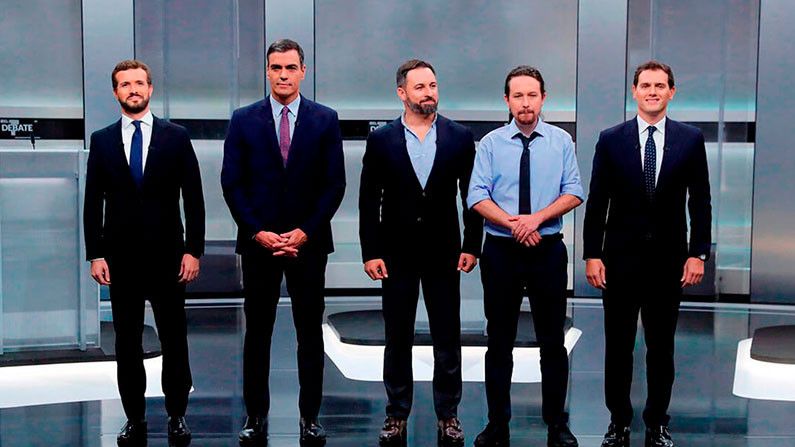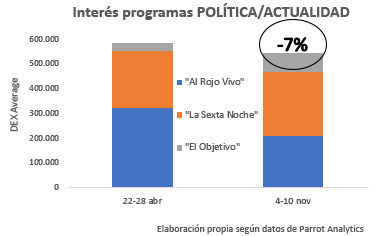What level of interest did Spaniards have in political content during the last 2 weeks of 2019?
The political situation in Spain has dominated much of the television programming and activity on social media networks in the past few months. But does this translate into a genuine interest on the part of citizens in content that deals with this issue? At Mediacrest we want to provide an unbiased answer.
2020-01-22

The voter turnout in the April 28th elections was 71.76% while in the November 10th elections it was 69.32%, marking a 3.4% decline. As our main concern is what this decrease in interest in political content translates into, we have compared both election weeks (November 4-10 vs. April 22-28) from different consumption sources. different points of view.
Firstly, we have the consumption of linear televisioni. It should be remembered that this is passive consumption and subject to static programming and competition, so linear consumption is the average number of people who watched television in both weeks:
- At first, we observe that the number of viewers drops slightly. It goes from 7,272,000 viewers in the week of April to 7,212,000 in the week of November, a 1% decline. This is hardly significant, but perhaps more so if we look at in which age ranges it falls and which it rises in:
- The most relevant point here is that the number of viewers drop mainly among those aged under 44 (31%).
- On the other hand, it increases among those over 45 (6%).
- However, the most significant fact is that if we compare the equivalent weeks in 2018 (November 5-11 vs. April 23-29, 2018), TV consumption did grow during that time, from 7,005,000 viewers on average to 7,293,000, up 4.1%. The increase was reflected in all age groups except young people aged 13 to 24 (-1.8%). That is, the same week of November 2018 not only saw more television, but grew compared to months earlier, the opposite of 2019.

The second, in terms of interestii (active consumption and, therefore, more reliable in terms of what really 'interests' the viewer because the viewer takes the initiative to 'choose' it) shows the public interest towards 3 of the most notable political and current affairs programs (Al Rojo Vivo, La Sexta Noche and El Objetivo):
- In general, it also decreases. In this case 7%.
- Although the interest in two of the programs analysed is growing (La Sexta noche and El Objetivo), the growth is not enough to compensate for the decrease in interest in Al Rojo vivo that causes the general demand for the 3 programs to fall.

Finally, with regard to the interactions that have been made in Social Mediaiii:
- With the trend in television consumption going down, social media networks have become a refuge of political interest for citizens:
- Total mentions of the main political parties have doubled from almost 1.7 million in April election week to just over 3.4 million in November.
- The total number of mentions of the leaders of the five main parties also increased by 56%.
- The party and the political leader that got the most mentions in April was Pablo Iglesias (United We Can), while in November it was Pedro Sánchez (PSOE), followed by Santiago Abascal (Vox).

In short, it seems that the 'conventional' interest (what translates into electoral participation and audiovisual consumption) in the 2 electoral weeks of 2019 decreased, but not another type of interest that we could call 'unconventional' (the one that translates into ‘buzz’ in social networks.
The shift in interest of Spaniards from TV to social media networks may be due to many factors, such as the weariness of electoral repetitions, a greater need to get involved instead of being simple passive elements, or a greater commitment of the parties in this digital scenario.
At Mediacrest, we do not have the answer to why this shift is happening, but we are constantly aware of the changes in the forms of audiovisual consumption and the ways in which the audience interacts with the content. It is crucial for us to know them in order to be able to predict their taste and make productions according to them.
iSource: Kantar via Dos30.
iiSource: Parrot Analytics.
Interest is understood as the participation that a program awakens in the viewers, translated into actions around it such as likes in fan pages, information searches, comments in dedicated pages or downloads and re-viewing of the program. However, more importance is given to downloads and views than to comments or likes in Social Networks.
iiiSource: Digimind.
Social Media analysed: mainly Twitter, Facebook, Instagram and News. Main parties analysed: PSOE, PP, Ciudadanos, Vox and Unidas Podemos. Main political leaders analysed: Pedro Sánchez, Pablo Casado, Albert Rivera, Santiago Abascal and Pablo Iglesias.
If you liked it, share it
